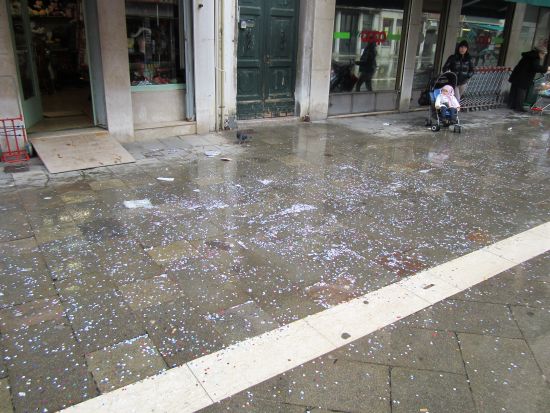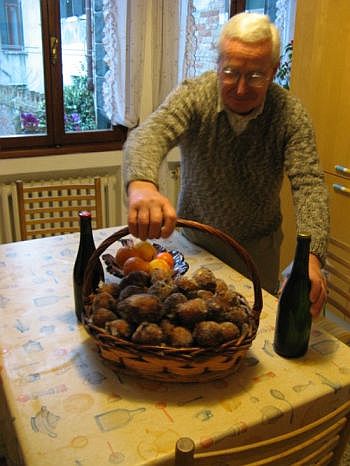
I have nothing positive to say about Carnival, except that it lasts a relatively short time. “Relative” is relative, though, because this year will hold the longest Carnival ever: January 26-February 12, or eighteen days, or almost three weeks. Zounds.
Of course, compared to the Old Days, it is short. Back then, Carnival could last six months. So? Lino says that if the city could make it last from January to January, they’d do it.
Actually, there is one thing which I love about it, and that thing is kids. The neighborhood tykes with their painted-on whiskers and frilly tulle princess costumes and especially their fistfuls of confetti (here called coriandoli).
Erudition alert: Why do we call them confetti and the Italians say coriandoli? Here, confetti refers to the almonds covered with a carapace of sugar, given to guests on festive occasions and colored accordingly (weddings, anniversaries, baptisms, First Communions, etc.).
In the most ancient celebratory days, it was coriander seeds which were used in sweets called confetti, presumably because they had been confected. Documents attest that at weddings or Carnival during the Renaissance, sweets (confetti) containing coriander seeds were often tossed festively at fellow revelers.
In 1875, Enrico Mangili, an enterprising engineer from Crescenzago, near Milan, decided to sell, as a substitute for real coriander-containing sweets, the tiny disks of paper left over from the perforated paper used by the silk industry. Voila’! Symbolic coriander/confetti which were cheap and, as we might say now, rigorously recycled. I can imagine with what enthusiasm the city’s pastry-makers greeted this innovation. If they were inclined to throw anything, it probably wasn’t sugared.
In any case, as you see, the two terms underwent mitosis.
So far, I haven’t seen costumes or makeup, but the Carnival spirit has already begun to simmer along via Garibaldi. Fritole and galani are already on sale, and I’ve heard the distant cries of tiny swarming humans. And they’ve left their gladsome spoor along calli and campi. There is no day so dull that it could not be brightened by these bits of colored paper.
I’ve decided that these snippets are the mystic spores from which Carnival germinates and eventually fruits, producing great harvests of masks and fritole and galani.
To which I say, throw more.


8 Comments
Oh, Erla, you are such a tease! The one thing I truly adored about Carnevale was the fritelle that became “What I eat, I am”. I haven’t timed my return very well, it seems.
Thanks for the wee history lesson, also.
I realize I could make galani any time I want, but something deep and primeval prevents me. If I don’t eat them before Ash Wednesday, I have to wait a whole year to try again. As for the history lesson, I welcome further erudition from somebody because the brief research I did left me with the feeling of having connected a few dots in an eccentric way, so to speak. But then again, where Carnival’s concerned, how does one define “eccentric”?
Now, really, this is TOO much. Fritelle shall not be thrown, tossed or otherwise – except if it’s in the MOUTH. When they are good, they are too, too good to waste. …and I’ll wager my neighbours’ against your bakers’! (Mmmm, let’s eat some of each and see which are better, yeah?)
I would accept your challenge gladly, but it’s not in my power to compel my magician of the fritole to work his occult wizardry. Why don’t you just throw me some and I’ll decide whether they’re as good as his?
Ok Erla, What is this Fritole you speak of?? and is Carnival the same as Mardi Gras?? Do you get beads… 😉
“Fritole” is Venetian for frittelle. They are pictured in the photograph on the post. Here’s a recipe for them: http://www.ricardocuisine.com/recipes/2127-frittelle-italian-carnival-doughnuts- Mardi Gras is the last day of Carnival anywhere in the world. How many days of partying precedes it depends on lots of various factors. The day after Mardi Gras is Ash Wednesday, when the party’s over.
Dear Erla
I am very sorry you do not like our beautiful Carnival. I can only think it is because maybe you came over here in Venice as an adult and did not get to experience it first as a child. When we were children Carnival was just magnificent! Venetians from the city and those like me from dry land (terraferma) just love Carnevale and it is not just the frittelle and galani! it something which goes deeper. I have to say Carnival during from 1999 till 2009 was very dissapointing (I even wrote about this in my blog) , but now I can see it seems like it is getting back to the way it used to be when a was a child: packed with people dressing up, partying all the time, eating all sorts of cakes. Probably the economical crisis makes people try harder in having a good time. Not too sure about the drank people around the city, though – but this is new, it did not happen when I was a kid. Anyway I hope you will have a nicer Carnival this year!
I’m glad you have happy memories. But you say that Carnival was disappointing between 1999 and 2009 — i.e., for ten solid years. That’s quite a chunk of disappointment, which I think might justify my not being so enthusiastic about this event. In any case, I doubt that it can ever get back to being the way it used to be when you were a child, partly because it’s extremely rare that something goes back to being the way it was for people when they were children. It also seems unlikely that an adult could experience an event in the same way he or she did as a child. In any case, it has long since become a huge touristic business, and this tends to limit the joy, simplicity, spontaneity, and other aspects of Carnival which make it enjoyable. Perhaps on the mainland it’s different from here in the city.